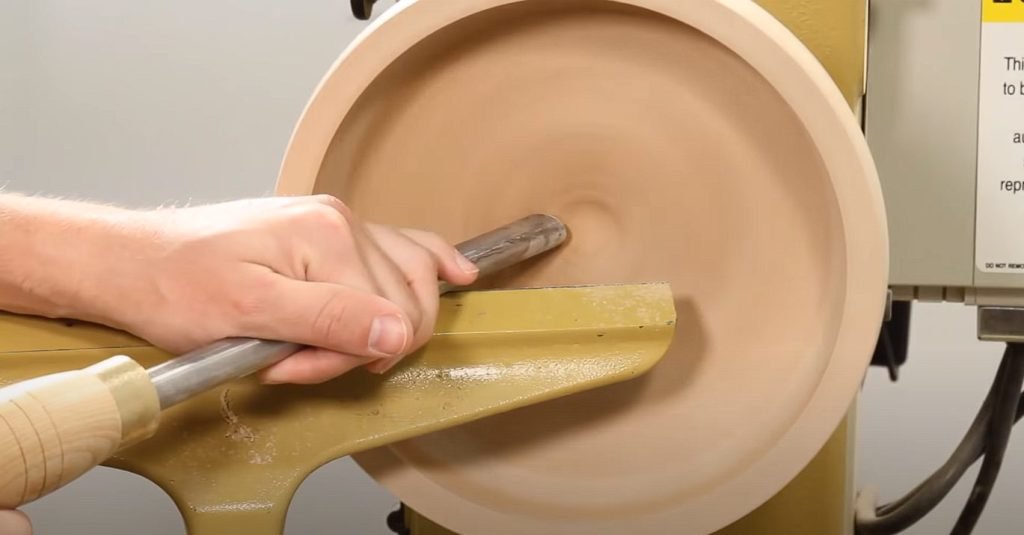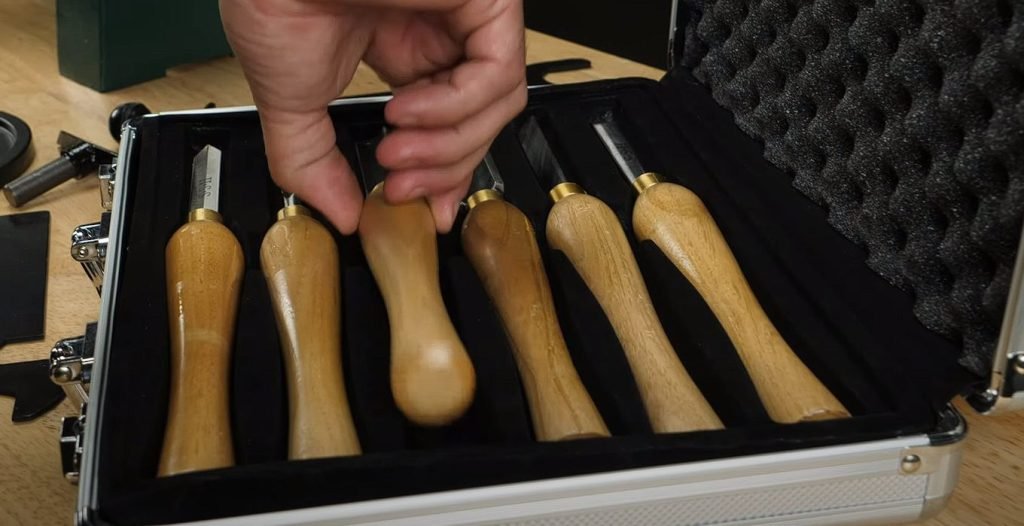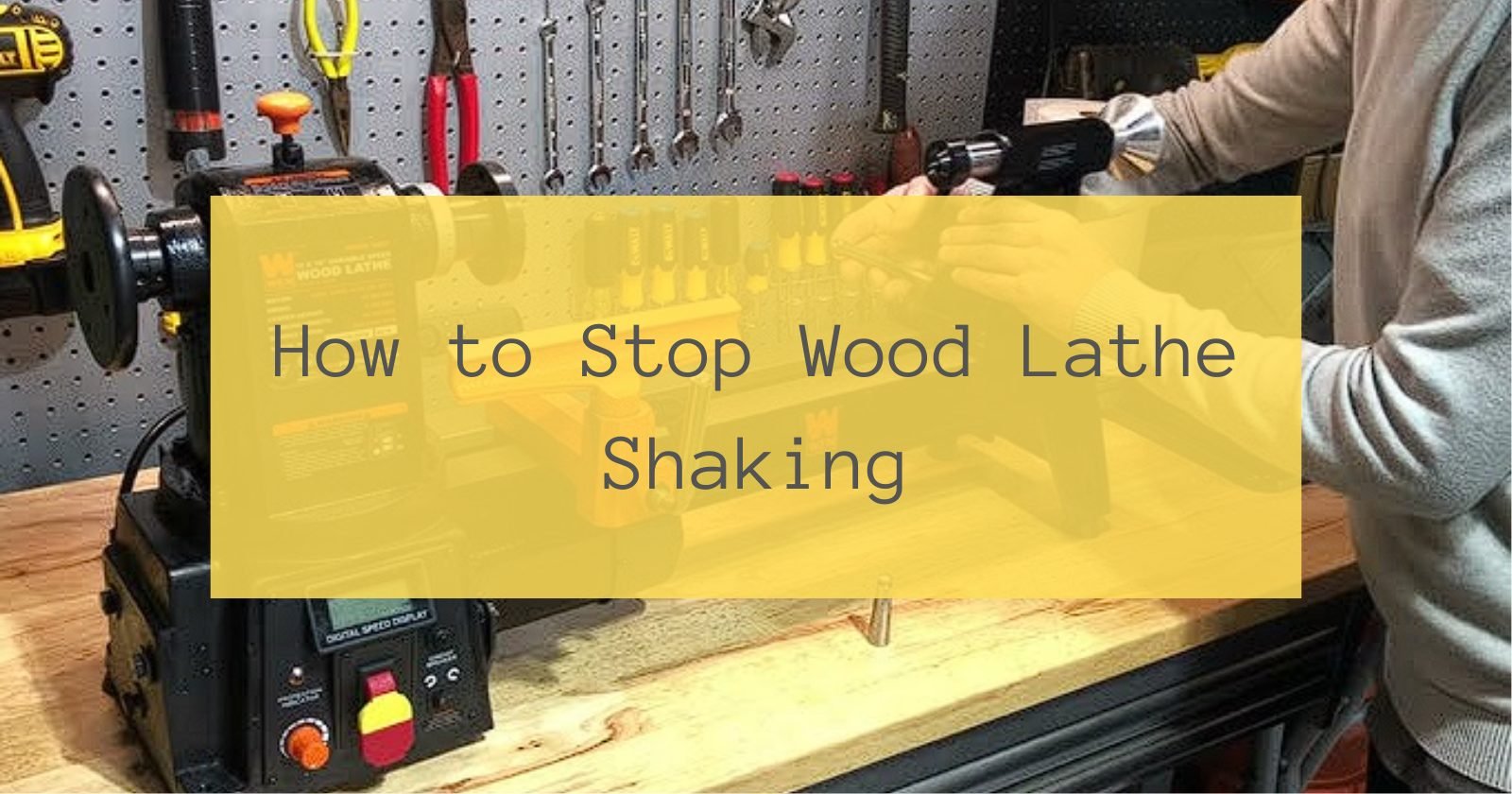Table of Contents
To reduce wood lathe shaking, ensure the lathe is on a stable surface, ideally on a sturdy workbench or stand with legs. Check that the lathe’s legs or base, tool rest, spindle, headstock bearings, and rotation are secure and not wobbling. Additionally, ensure your workpiece is well-balanced and firmly secured on the lathe. Avoid turning the motor at excessively high speeds, leading to vibration; choose an appropriate rotation speed for your project. Lastly, use sharp tools such as a bowl gouge and take light cuts to minimize vibration when turning. These steps should help you cut down on wood lathe shaking for smoother operation when using the tool.
The Gouge Vibration Causes and Prevention
Dull or Improperly Sharpened Tools
Dull or improperly sharpened tools often cause gouge vibration. When the cutting edge of a gouge tool is flat, it tends to catch on the wood, leading to shaking and vibration. By properly sharpening the tools, woodworkers can minimize the issue of cut, gouge, and oak. Proper sharpening ensures that the gouge cuts smoothly through the wood without causing excessive vibration.
Maintaining sharpness by regularly honing and sharpening the gouges using appropriate tools, such as a bench grinder or a dedicated sharpener, is essential. Learning how to recognize signs of dullness in gouges can help prevent vibration issues before they occur.
Proper Tool Technique and Angle
The technique used when handling gouges, tools, cuts, and spindles is crucial in minimizing vibration issues. Woodworkers should maintain consistent pressure and speed using lathe tools such as spindles, gouges, and cuts. Holding the wood lathe tool at an incorrect angle can lead to unnecessary shaking during turning, causing vibration. Ensuring proper technique with the gouge will significantly reduce vibrations during woodturning processes.
One helpful personal tip for reducing vibration due to improper technique is practicing patience and learning correct tool-handling methods through trial and error. It’s essential not to rush through these techniques, such as spindle turning and bowl blank preparation, but instead take deliberate steps towards mastering them for smoother turning experiences.

High-quality gouges with Proper Flute Design
High-quality gouges with proper flute design, spindle, and bowl blank can also help prevent vibration during wood lathe operations. Quality tools, including the spindle, are less prone to producing excessive vibrations due to their superior construction materials and precise manufacturing processes.
Investing in good-quality gouges may require some initial financial commitment. Still, it pays off in improved performance, reduced vibrations, an enhanced overall woodworking experience, happy turning, and bowl blank.
Ensuring Solid Footing for Lathe Stability
Leveling the Lathe
Ensuring that your wood lathe is placed on a level surface is essential in minimizing shaking during happy turning with a bowl blank. A stable foundation prevents unnecessary movements that can lead to vibrations during turning. Using a superficial spirit level, you can quickly check and adjust the lathe’s position to ensure it’s perfectly leveled for turning a bowl blank.
Adding shims or adjusting the feet of the lathe can help achieve stability when turning a bowl blank. This simple step significantly reduces any wobbling or shaking caused by an uneven surface, allowing you to work more efficiently and produce smoother finishes on your woodturning projects.
Securing a Sturdy Workbench
Securing your wood lathe and bowl blank to a sturdy workbench or stand is crucial in reducing unwanted vibrations. Attaching the lathe securely prevents it from moving around, improving stability and smoother operation when working with a blank bowl.
For maximum stability, consider bolting down the lathe and bowl blank onto a heavy-duty workbench with solid legs. This ensures that even when working with larger pieces of wood, such as bowl blanks, the lathe remains firmly anchored at higher speeds, resulting in minimal shaking and better turning results.
Adding Weight to the Base
Another effective method for minimizing wood lathe shaking involves adding weight to its base, bowl blank. Placing sandbags or other heavy materials around the lathe’s base, such as a blank bowl, helps dampen vibrations by increasing its overall mass.
Inspecting and Maintaining the Drive Train
Regularly Inspecting
Inspecting the drive train and bowl blank is crucial to prevent excessive vibration. Look for any wear or damage on the gears, belts, and pulleys. Check for any loose components or wood lathe vibration that may contribute to shaking during operation.
Inspecting the drive train, wood lathe vibration, blank, and bowl should be a routine part of your maintenance schedule. By identifying issues early on, you can address them before they escalate. A thorough bowl inspection ensures smooth rotation without unnecessary shaking or vibrations.
Lubricating Gears
Lubricating gears is essential for ensuring their smooth operation. Use appropriate lubricants recommended by the lathe manufacturer to keep the gears running smoothly. Proper lubrication reduces friction and minimizes vibration during the turning process.
Applying lubricant at regular intervals helps maintain optimal performance and extends the lifespan of the gear components. This simple maintenance task significantly reduces wood lathe vibration while enhancing operational efficiency.
Replacing Worn Belts
Worn belts are a common cause of wood lathe shaking. Regular checks should be conducted to identify any signs of wear or deterioration. Replace worn-out belts promptly to restore stability during turning processes and reduce wood lathe vibration.
In addition to replacing worn belts and checking and replacing damaged pulleys, it is equally important to minimize vibration concerns. Proactively addressing bowl and wood lathe vibration components can lead to more stable operations and a smoother turning experience overall.
Checking Headstock and Connection Integrity
Tightening Connections
Regularly check the headstock, spindle, and bowl connections to ensure they are secure. Loose connections can lead to excessive shaking during woodturning. Use a wrench or appropriate tool to tighten any loose bolts or screws in these areas.
Maintaining the stability of the headstock, spindle connections, and bowl is crucial for smooth wood lathe operation. Ensure all components, including the bowl, are properly secured and free from play or movement.
I’ve found that a simple check before starting any project, including checking the bowl, helps prevent unnecessary vibrations and ensures a safer turning experience.
Upgrading Equipment
If tightening the existing connections doesn’t resolve the shaking issue, consider upgrading to a higher-quality headstock or spindle. A sturdier, more robust headstock with better headstock bearings can significantly reduce vibrations during woodturning.
Upgrading your equipment not only enhances stability but also improves overall performance. When I upgraded my lathe’s headstock bearings, I noticed a remarkable reduction in shaking and increased precision while working on various projects.
Investing in high-quality components, such as a bowl, may require some initial expenditure but pays off through improved efficiency and smoother operation over time.
Managing Lathe Speed and Tailstock Support
Adjusting Lathe Speed
Adjusting lathe speed based on the workpiece and bowl can significantly reduce vibrations. For larger diameters, using a lower speed is advisable to maintain stability. Conversely, higher speeds are suitable for smaller workpieces. By matching the lathe’s speed to the specific requirements of each bowl project, you can minimize shaking and ensure smoother turning.
Maintaining an optimal variable speed throughout the turning process, including the bowl, is crucial for reducing vibrations. For instance, when working with irregularly shaped or unbalanced wood pieces, starting at a slower speed and gradually increasing it as needed can help prevent excessive shaking.
Adjusting lathe speed according to the workpiece and bowl reduces shaking and enhances precision in my wood-turning projects.
Tailstock Support
Proper tailstock support, such as employing live centers or other stabilizing accessories, minimizes vibrations during wood lathe operations. Live centers provide continuous support to the rotating workpiece, promoting stability and reducing wobbling or shaking.
Avoiding excessive pressure on the tailstock prevents unnecessary vibrations during woodturning. Applying too much pressure can lead to distortion and imbalance in the workpiece, resulting in unwanted oscillations, rough finishes, and bowls.
In my experience, ensuring adequate tailstock support has been instrumental in achieving smoother turning outcomes with minimal shaking.
Stabilizing Techniques for Irregular Workpieces
Using Steady Rests
Steady rests are essential for stabilizing irregularly shaped workpieces, such as bowls, on a wood lathe. They provide support to the workpiece, preventing excessive vibration during turning./// By using steady rests, turners can effectively manage the challenges of irregular shapes, including bowls, ensuring a smoother and safer turning process. These devices are handy when working with pieces with varying diameters or non-uniform contours, such as a bowl.
Steady Rests:
- Provide crucial support for irregularly shaped workpieces
- Help prevent excessive vibration during turning
- It is beneficial when dealing with pieces of varying diameters or non-uniform contours and bowls.
Balancing the Workpiece
Balancing the workpiece is another effective method to minimize shaking on a wood lathe. This involves strategically positioning the piece and minimizing overhang to reduce vibrations. By achieving better balance, turners can significantly decrease unwanted movements and achieve smoother cutting results.
Balancing Tips:
- Position the workpiece strategically to achieve better balance
- Minimize overhang to reduce vibrations and shaking
Taking Lighter Cuts and Proper Tool Technique
Using the proper tool technique, taking lighter cuts is critical to controlling vibrations on a wood lathe. When dealing with irregular workpieces, it’s essential to adjust cutting depths accordingly and use appropriate tool techniques that minimize strain on both the piece and the lathe.
Lighter Cuts & Tool Technique:
- Adjust cutting depths according to the characteristics of each workpiece
Addressing Low-Quality Lathe Stands and Mounting
Upgrading to Quality Stands
Upgrading to sturdy stands can significantly reduce wood lathe shaking. Low-quality stands often lack the stability needed for smooth operation. A well-designed stand provides a solid foundation, minimizing vibrations during turning. For instance, a heavy-duty metal stand with adjustable feet offers enhanced stability.
Investing in a quality stand reduces shaking and enhances safety and precision. A sturdy base ensures the lathe remains steady even with more extensive or unbalanced workpieces. This upgrade is essential for woodturners looking to achieve professional results without the distraction of excessive vibration.
Proper Securing Techniques
Properly securing the lathe to the stand or workbench reduces vibrations. Using appropriate mounting hardware such as bolts, washers, and nuts helps minimize movement during operation. Ensuring that the lathe is securely fastened prevents unnecessary wobbling and shaking.
When I upgraded my old wooden bench to a heavy-duty steel stand with adjustable feet, I noticed an immediate improvement in stability while turning bowls and spindles on my wood lathe. The reduced vibration allowed me to focus more on refining my turning techniques rather than struggling with uncontrollable shaking.

Sharpening Gouges with Precision for Smooth Operation
Consistent Bevel Angles
Maintaining consistent bevel angles on gouges is crucial for reducing wood lathe shaking. When the bevel angle is inconsistent, it can lead to uneven cutting and cause unnecessary vibration. By ensuring that the bevel angle remains constant, you can achieve smoother cuts and minimize the shaking of the lathe.
It’s important to note that a consistent bevel angle improves performance and enhances safety during turning. The precision in maintaining this angle directly affects the quality of your workpiece and reduces the chances of encountering juddering or other issues related to wood lathe shaking.
High-Quality Sharpening Tools
Using high-quality sharpening tools and techniques minimizes vibration when working with a wood lathe. Quality tools help achieve sharper edges, resulting in smoother operation and reduced shaking. For instance, a well-crafted bowl gouge with sharp edges allows for precise cuts without causing excessive vibration.
Investing in top-notch sharpening equipment such as grinding wheels and honing jigs ensures your tools are correctly maintained, improving performance while turning bowls or other wooden workpieces.
Conclusion: Mastering Vibration Reduction on the Wood Lathe
Mastering vibration reduction on the wood lathe is crucial for achieving precision and smoothness in turning operations. Woodworkers can significantly minimize lathe shaking by understanding the causes of gouge vibration, ensuring stable footing, maintaining the drive train, and implementing stabilizing techniques. Checking the headstock and connection integrity, managing lathe speed, addressing low-quality lathe stands, and sharpening gouges with precision are also essential steps in this process. With a comprehensive approach to vibration reduction, woodturners can elevate the quality of their work and enhance safety in the workshop.
Now, it’s time to implement these strategies and experience the difference firsthand. Take the necessary steps to implement vibration reduction techniques on your wood lathe and observe the transformation in your turning projects. Embracing these methods will refine your craftsmanship and create a more enjoyable and efficient turning experience. Let’s turn those shaky challenges into smooth triumphs!
Frequently Asked Questions
How can I reduce wood lathe shaking?
To reduce wood lathe shaking, ensure the lathe is on a stable surface, inspect and maintain the drive train for any issues, stabilize irregular workpieces using techniques like adding weight or support, and sharpen gouges with precision. Managing lathe speed and tailstock support also helps in reducing vibration.
What are some common causes of wood lathe vibration?
Common causes of wood lathe vibration include an unstable footing, issues with the drive train, poor connection integrity at the headstock, low-quality stands or mounting systems, and irregular workpieces that are not adequately stabilized.
How do I ensure stability for my wood lathe?
To ensure stability for your wood lathe, place it on a solid footing to minimize vibrations. Inspect and maintain the drive train regularly to prevent any issues leading to instability during operation.
Why is it important to sharpen gouges with precision for smooth operation?
Sharpening gouges with precision ensures they cut smoothly through the wood without causing unnecessary vibrations. Dull tools can lead to rough cuts and increased shaking of the lathe during operation.
What role does managing lathe speed play in reducing vibration?
Managing lathe speed is crucial as higher speeds can exacerbate vibrations while lower speeds may not provide sufficient cutting efficiency. Finding an optimal speed based on workpiece size and material type helps minimize unwanted vibrations.
